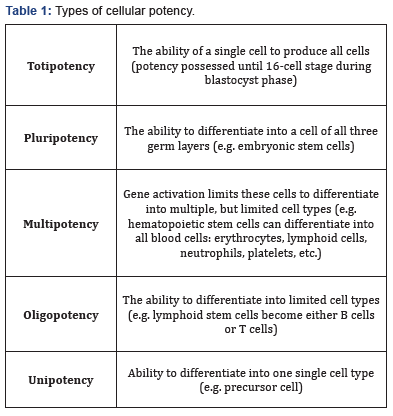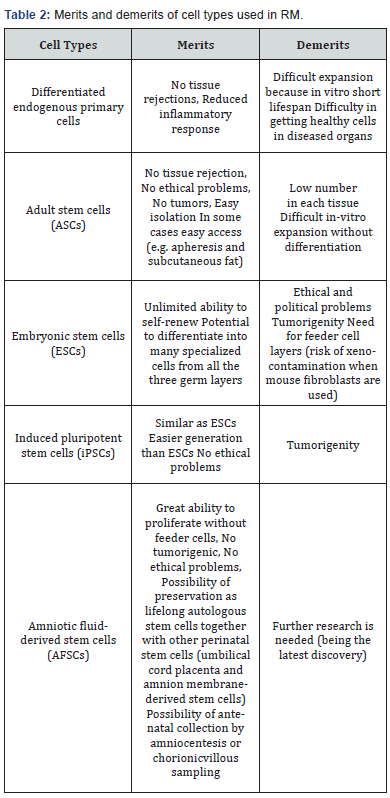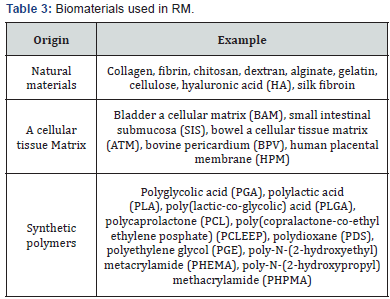Prospects and Potential of Regenerative Medicine
Sarvesh Sharma*and Vimal Kumar
Department of Biotechnology, LNCP, India
Submission: February 21, 2018; Published: May 25, 2018
*Corresponding author: Sarvesh Sharma, Associate Professor, Dept of Biotechnology, LNCP, Bhopal, India.
How to cite this article: Sarvesh S, Vimal K. Prospects and Potential of Regenerative Medicine. Adv Biotech & Micro. 2018; 9(3): 555764. DOI: 10.19080/AIBM.2018.09.555764
Abstract
Regenerative medicine concept is advancement in biomedical application which is based on the principles of stem cell technology and tissue engineering in order to restore human tissue and organ’s functions. This novel scientific approach is opening to represent a valuable treatment option for acute injuries, chronic diseases and congenital dysfunctions. This mini review is to express the state of art in regenerative medicine used strategies and burning problems to solve in the future.
Introduction
The every multi-cellular organism survival depends on the balanced cell division and cell death. Regenerative medicine (RM) involves the replacement or regeneration of human cells, tissue or organs, to re-establish their normal functions. RM is considered a novel front line of medical research, but the idea of creating artificial organs is not so recent [1]. The regeneration of body parts is a rather common phenomenon in nature; a salamander can regenerate an amputated limb in several days. Humans have this ability as well, but they lose it over the years: a severed fingertip can regenerate until 11 years of age. The human regeneration potential was well-known also in ancient times, as demonstrated by the myth of Prometheus: his liver was eaten by an eagle during the day and it completely regenerated itself overnight.
The medical and pharmaceutical sciences gained many success, but there are still many situations requires the resection of lesions or repair with autologous tissue or allograft. Tissue or organ rejection after transplantation was very common due to immunological responses, but the advent of cyclosporine (Immunosuppressive agent) the risk of rejection could be reduced [2]. There are two drawbacks of organ transplantation i.e. life-long immunosuppressive agents showed many side effects and the shortage of similar donors, not being able to meet increasing demand of organs.
Present Strategies of Regenerative Medicine
Following approaches trail the objective of RM
A. Cell based therapy
B. Immobilized biological or synthetic material to lead repair and growth
C. Implantation of scaffolds seed with cells
Cell based therapy
However, all cells come down from one exclusive cell, called zygote. During development, cells differentiate gradually and acquire more and more specific tasks, while they lose their capacity for differentiating into other cells. The ability to differentiate into other cell types is defined as “cell potency” (Table 1). Cell therapy consists of injecting novel and healthy cells (differentiated endogenous or undifferentiated stem) in diseased tissues, which can differentiate depending on meticulous circumstances (Table 2).


Immobilized biomaterials
Tissues generally consist of cells and extracellular matrix (ECM). Biomaterials usually serve as ECM, giving both structural and functional support. During the last few years, ECM has been shown to play a key role in different functions, such as gene expression, survival, death, proliferation, migration, differentiation. Therefore, all of them should be reproduced by biomaterials enriched with bioactive factors, such as growth factors and cytokines. The materials used in RM (Table 3) can be classified as natural or synthetic with different advantages and disadvantages.

The ideal biomaterial should be biocompatible and biodegradable at the same rate as regeneration process without leaving toxic end-products, interfering with regeneration process and causing inflammation and/or obstruction. A technology, called dynamic optical projection stereolithography, complex 3D microstructures, like blood vessels, can be printed within few seconds. Without vasculature printing, essential for distributing nutrients and oxygen, tissue-engineered organs, such as liver or kidney, are useless in clinical practice. The biofabrication technique grounds on a photo-induced solidification process, which uses soft biocompatible hydro-gel containing living cells and forms one layer of solid structure at a time, but in a continuous fashion, by shining light on a selected area of a solution containing photo-sensitive biopolymers and cells.
Implantation of scaffolds seed with cells
This is a combination move toward of previous two techniques. In 2006, Atala et al. [3] reported autologous engineered bladder constructs could be used in patients suffering from myelomeningocele needing augmentation cystoplasty. The synthetic scaffold was made up of collagen and PGA and seeded with patient’s urothelial and smooth muscle cells, respectively on the endoluminal and abluminal side [4-7]. These cells were obtained through a patient’s biopsy and expanded in vitro before scaffold seeding.
Conclusion
RM opened new avenues for curative patients with difficultto- treat diseases and physically impaired tissues. Despite many successes, RM is still unfamiliar to many scientists and clinicians [8]. This poses a great limit, as tissue engineering and regenerative medicine could overcome the unsolvable problems of the current medical treatments. In order to resort to RM in the clinical setting on a daily basis, it is mandatory to obtain important financial investments from different sources including governments and industries that are oriented toward research and medical innovation [9,10]. There is a considerable need for long-term vision and support for RM to accelerate the development of novel therapies and to promote the stability of collaborations around the world. The crucial point of this revolution is transforming the current numerous scientific discoveries into novel and viable therapies: from bench to bedside.
References
- Mason C, Dunnill P (2008) A brief definition of regenerative medicine. Regen Med 3(1): 1-5.
- Nelson TJ, Behfar A, Terzic A (2008) Strategies for therapeutic repair: the R3 regenerative medicine paradigm. Clin Transl Sci 1(2): 168-171.
- Atala A, Bauer SB, Soker S, Yoo JJ, Retik AB (2006) Tissue-engineered autologous bladders for patients needing cystoplasty. Lancet 367(9518): 1241-1246.
- Atala A (2012) Regenerative medicine strategies. J Pediatr Surg 47(1): 17-28.
- Ilic D, Polak JM (2011) Stem cells in regenerative medicine: introduction. Br Med Bull 98: 117-126.
- Barrilleaux B, Phinney DG, Prockop DJ, Oconnor KC (2006) Review: ex vivo engineering of living tissues with adult stem cells. Tissue Eng 12(11): 3007-3019
- Pacini S (2014) Deterministic and stochastic approaches in the clinical application of mesenchymal stromal cells (MSCs). Front Cell Dev Biol 12(2): 50
- Gelain F, Panseri S, Antonini S, Cunha C, Donega M, et al. (2011) Transplantation of nanostructured composite scaffolds results in the regeneration of chronically injured spinal cords. ACS Nano 5(1): 227- 236.
- Arenas Herrera JE, Ko IK, Atala A, Yoo JJ (2013) Decellularization for whole organ bioengineering. Biomed Mater 8(1): 014106.
- Zhang AP, Qu X, Soman P, Hribar KC, Lee JW, et al. (2012) Rapid fabrication of complex 3D extracellular microenvironments by dynamic optical projection stereolithography. Adv Mater 24(31): 4266-4270.






























